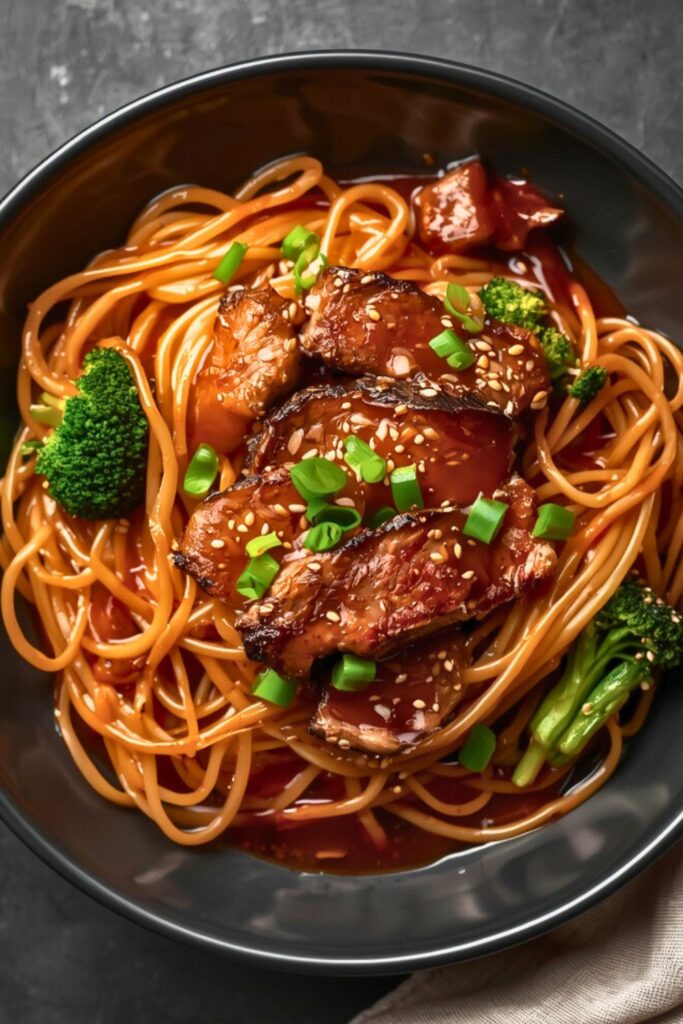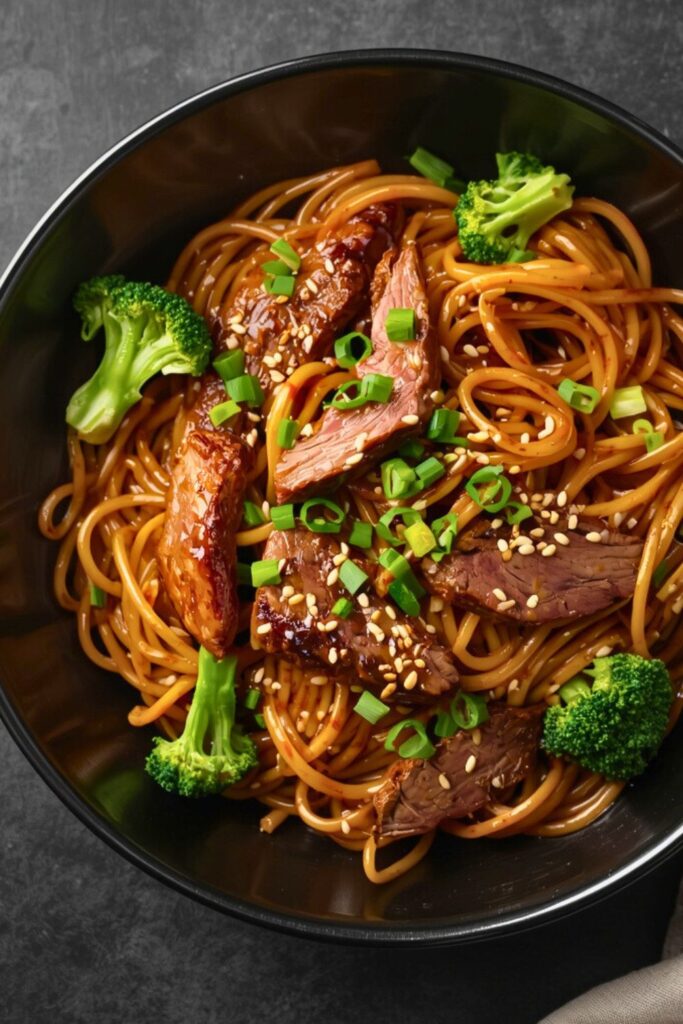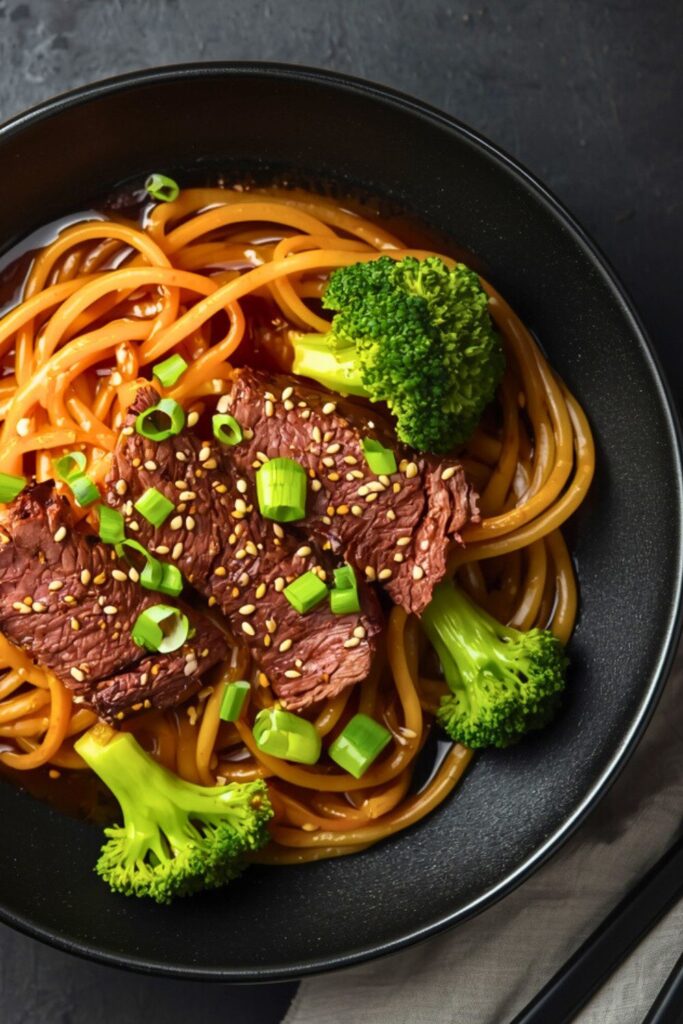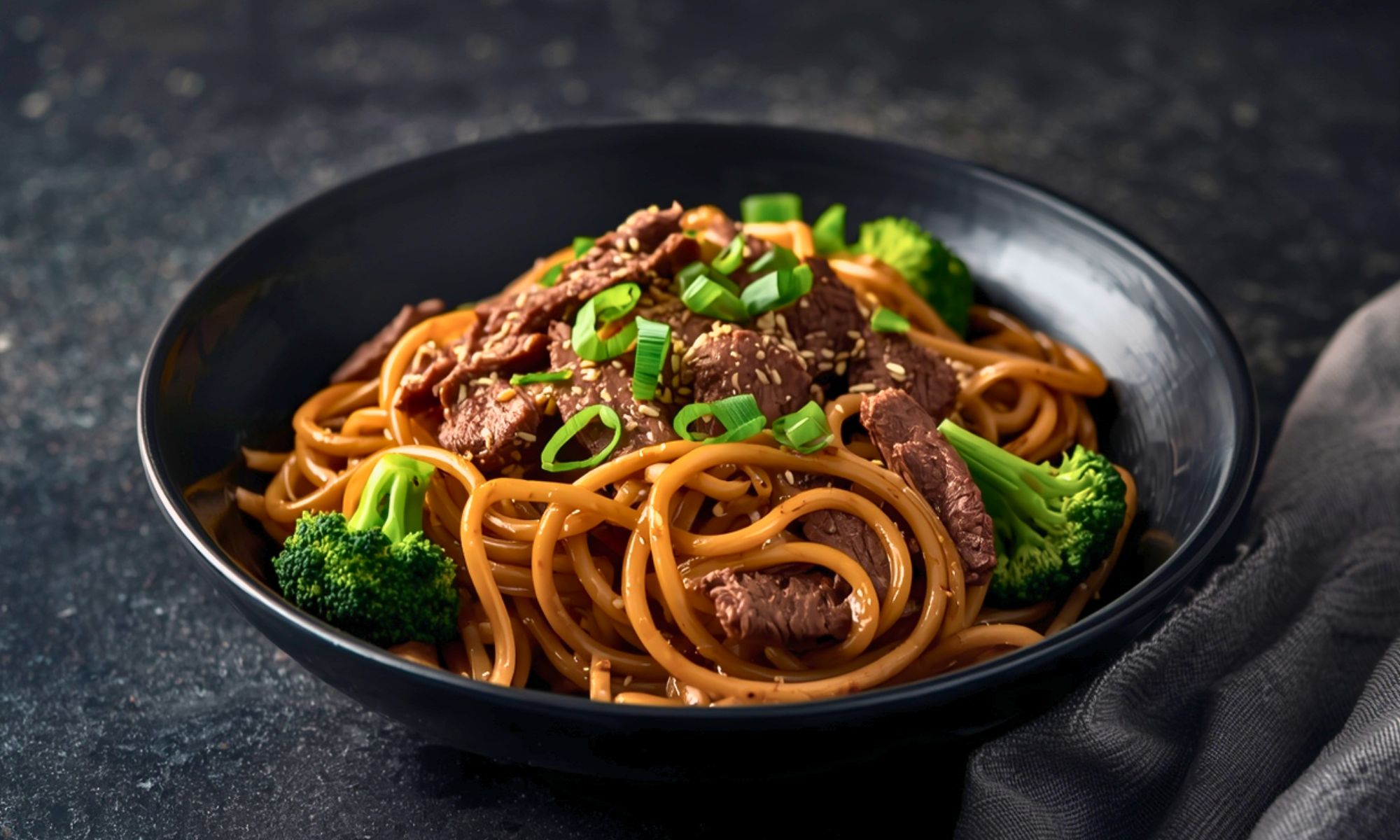Busy as today’s lifestyle can be, there’s always that moment when hunger strikes harder than your to do list. You’re tired, the clock is laughing at you, and the last thing you want is another overpriced delivery order that tastes like regret.
What you need is fast comfort that doesn’t cut corners, and that’s exactly where Homemade Beef and Broccoli Lo Mein slides in, bold enough for a weeknight recipe but nostalgic enough to feel like it’s been waiting in your kitchen all along.
I didn’t stumble on this dish through fancy planning, it happened during one of those half stocked fridge nights. Beef sizzling in the pan, broccoli snapping bright, soy and garlic weaving together into a sauce that smelled way too good to be an accident. Suddenly, what started as a scramble for dinner became the kind of quick dinner comfort food you actually look forward to repeating.
This recipe proves that takeout favorites can live at home without the fuss. It’s flavorful, budget friendly, and flexible, perfect for busy weeknights, family meals, or whenever you need something satisfying without slowing down. Stick with me and I’ll walk you through simple steps, swaps, and tips to nail this dish every single time.
Getting Started – The Foundation of Great Lo Mein

Let’s talk about what makes lo mein special. It’s all about the noodles, friend. Lo mein literally means “tossed noodles” in Cantonese. These aren’t your average pasta strands.
Fresh lo mein noodles have this incredible chewy texture. They grab onto sauces. They wrap around ingredients like they’re giving them a warm hug. When you get the technique right, every single bite is perfection.
The secret sauce? It’s simpler than you think. Soy sauce forms the backbone. A touch of oyster sauce adds depth. Sugar balances the salt. Cornstarch creates that glossy coating that makes everything shine.
But here’s where most people mess up. They think it’s about the sauce alone. Wrong. It’s about timing. Temperature. The order you add ingredients. Miss these details, and you’ll end up with soggy noodles and tough beef.
I’m gonna walk you through every step. Share the tricks I learned through trial and error. By the end, you’ll be making lo mein that rivals your favorite restaurant.
The Perfect Ingredients for Homemade Beef and Broccoli Lo Mein
Here’s your shopping list, in the exact order I use them:
For the beef marinade:
- 1 pound flank steak, sliced thin against the grain
- 2 tablespoons soy sauce
- 1 tablespoon cornstarch
- 1 teaspoon sesame oil
- 1/2 teaspoon black pepper
For the sauce:
- 1/4 cup low sodium soy sauce
- 2 tablespoons oyster sauce
- 1 tablespoon dark soy sauce (for color)
- 1 teaspoon sugar
- 1 teaspoon cornstarch
- 2 tablespoons water
For the lo mein:
- 1 pound fresh lo mein noodles (or 12 oz dried)
- 4 cups fresh broccoli florets
- 3 cloves garlic, minced
- 1 tablespoon fresh ginger, grated
- 3 green onions, sliced
- 2 tablespoons vegetable oil (divided)
- 1 teaspoon sesame oil for finishing
Smart Swaps That Save the Day
Can’t find fresh lo mein noodles? I get it. Not every grocery store stocks them. Here’s what works instead.
Dried lo mein noodles are your first backup. Cook them just shy of package directions. They’ll finish cooking in the wok.
No lo mein at all? Grab thick spaghetti or linguine. Seriously. Cook it al dente. It won’t be exactly the same, but it’ll still be delicious.
Flank steak too pricey? Sirloin works beautifully. So does skirt steak. Even ground beef if you’re feeling creative. Just adjust your cooking time accordingly.
Here’s a secret about oyster sauce. If you can’t find it, mix 2 tablespoons soy sauce with 1 teaspoon brown sugar. Add a tiny splash of fish sauce if you have it. Won’t be identical, but it’ll get you close.
Dark soy sauce gives that restaurant style color. But if you only have regular soy sauce? Use it all. Your lo mein will taste just as good, just lighter in color.
Picking the Best Ingredients
Let me share some insider secrets about shopping for this dish.
Fresh broccoli should feel heavy for its size. The florets should be tight and dark green. Yellow bits mean it’s past its prime. Trust your nose too, fresh broccoli smells clean and vegetal.
For beef, look for good marbling. Those white fat streaks mean flavor and tenderness. Don’t go too lean here. A little fat makes everything better.
Fresh ginger should have tight, smooth skin. If it’s wrinkled or soft, keep looking. Pro tip: store fresh ginger in the freezer. It grates easier when frozen.
Garlic heads should feel firm and heavy. Avoid any with green shoots poking through. Those are bitter.
Advanced Homemade Beef and Broccoli Lo Mein Techniques

Step 1: Marinate That Beef
Slice your beef super thin against the grain. This is crucial. See those muscle fibers running through the meat? Cut perpendicular to them. This breaks down the tough fibers and makes every bite tender. Trust me, your taste buds will thank you.
Toss the sliced beef with soy sauce, cornstarch, sesame oil, and black pepper. Let it sit for at least 15 minutes. Longer is better if you have time. The cornstarch does double duty here, it tenderizes and creates a silky coating when cooked.
Here’s a trick my Chinese cooking teacher shared. Put the beef in the freezer for 20 minutes before slicing. Partially frozen meat slices way easier and more evenly.
Step 2: Prep Like a Pro
Make your sauce by whisking everything together until smooth. No lumps allowed. Set it aside.
Cut your broccoli into bite-sized pieces. Not too small, they’ll shrink when cooked. Aim for pieces about the size of a walnut.
Mince your garlic and grate your ginger. Keep them separate but nearby. They’ll go into the wok at different times.
Heat your wok until it’s almost smoking, this is where flavor really wakes up.
Toss in the broccoli first to give it a quick, vibrant sear.
Get ready to add your aromatics in bursts; this is the moment your kitchen will start smelling irresistible.
Step 3: The Noodle Game
Bring a big pot of salted water to a boil. Fresh lo mein noodles cook fast, usually 2-3 minutes. Dried ones need longer, but still less than the package says.
Here’s the secret: you want them just shy of done. They’ll finish cooking in the wok with all those gorgeous flavors.
Drain the noodles and rinse with cold water to stop the cooking. Toss with a tiny bit of oil to prevent sticking. Set them aside.
Step 4: Wok Magic Begins
Heat your wok or largest skillet over high heat until smoking. This is key, we need serious heat for proper wok hei (that smoky flavor).
Add 1 tablespoon oil and swirl to coat. Add the marinated beef in a single layer. Don’t crowd it. Cook in batches if needed.
Let it sit undisturbed for 60 seconds. This creates that beautiful sear. Then stir fry for another minute until just cooked through. Remove to a plate.
Step 5: Vegetables Take the Stage
Same hot wok, add the remaining oil. Toss in the broccoli and stir fry for 2 minutes. It should be bright green and barely tender.
Add the garlic and ginger. Stir constantly for 30 seconds until fragrant. Don’t let them burn, burnt garlic is bitter.
Step 6: Bringing It All Together
Return the beef to the wok. Add the cooked noodles. Pour that gorgeous sauce over everything.
Now comes the fun part, the toss. Use tongs or chopsticks to lift and fold everything together. You want every noodle coated, every piece of beef and broccoli mingling.
Cook for 1-2 minutes, tossing constantly, until the sauce thickens and everything is heated through.
Common Pitfalls and How to Avoid Them
Don’t overcook the broccoli. It should still have bite. Mushy vegetables ruin the texture contrast that makes lo mein special.
Never add the sauce to a cold wok. The cornstarch needs heat to thicken properly. Cold wok equals gluey sauce.
If your noodles seem dry, add a splash of the noodle cooking water. The starch helps everything come together.
Make It Your Own
Love mushrooms? Add sliced shiitakes with the broccoli. They soak up all those delicious flavors.
Want more vegetables? Bean sprouts, snap peas, or carrots all work beautifully. Just adjust cooking times accordingly.
Feeling spicy? A teaspoon of chili garlic sauce in the marinade adds gorgeous heat without overwhelming the other flavors.
The Science Behind the Sizzle
Let’s talk about what’s really happening in that wok. When you heat oil until it’s smoking, you’re creating the conditions for the Maillard reaction. That’s the magic that gives us those beautiful brown edges and deep flavors.
The cornstarch in both the marinade and sauce serves multiple purposes. In the marinade, it creates a protective coating around the beef. This keeps moisture in and prevents overcooking. In the sauce, it acts as a thickener that creates that glossy, restaurant style finish.
High heat is crucial for proper stir frying. It cooks ingredients quickly, preserving textures and bright colors. Low heat steams food instead of searing it. That’s how you end up with soggy vegetables and tough meat.
The order of ingredients matters too. Proteins go first because they need the most cooking time. Harder vegetables like broccoli come next. Aromatics like garlic and ginger go in last because they burn easily.
Why Fresh Noodles Make a Difference
Fresh lo mein noodles have a completely different texture than dried. They’re already hydrated, so they don’t absorb as much liquid from your sauce. This means your final dish has more sauce flavor and better noodle texture.
They also have more elasticity. They bounce back when you bite them instead of just being soft. It’s that perfect chewy texture that makes great lo mein so satisfying.
The Cultural Connection
Lo mein has deep roots in Cantonese cuisine. It’s comfort food at its finest, simple ingredients transformed through technique into something greater than the sum of its parts.
In traditional Chinese cooking, balance is everything. Sweet balances salty. Soft balances crunchy. Hot balances cold. This dish embodies that philosophy perfectly.
Making It Beautiful and Delicious

Presentation matters, even for a simple noodle dish. Here’s how to make your Homemade Beef and Broccoli Lo Mein look restaurant worthy.
Use tongs to create a nice nest of noodles on each plate. Arrange the beef and broccoli on top and around the sides. This creates height and visual interest.
Garnish with those sliced green onions and a sprinkle of sesame seeds. The green adds color contrast, and the seeds add texture.
A drizzle of sesame oil right before serving adds aroma and makes everything glisten. Just a few drops, sesame oil is potent.
Perfect Pairings
This lo mein plays well with other Asian flavors. Start with some pork dumplings or spring rolls as appetizers.
For drinks, try jasmine tea or a crisp Riesling. The tea cleanses the palate between bites. The wine’s sweetness balances the soy sauce saltiness.
If you’re making this for a crowd, add some steamed rice on the side. Not traditional, but it helps stretch the dish and soaks up that delicious sauce.
Storing and Reheating
Lo mein is best fresh, but leftovers can work if you handle them right. Store in the fridge for up to 3 days.
To reheat, use a wok or large skillet with a splash of water or broth. The steam will refresh the noodles without making them mushy. Never microwave, it creates hot spots and ruins the texture.
Wrapping It Up
Here’s what makes this Homemade Beef and Broccoli Lo Mein worth your time. It’s faster than ordering takeout. Way more delicious. And you control every single ingredient.
The techniques you’ll learn here apply to so many other stir fries. Master the beef marinade, and you can use it for chicken, pork, or shrimp. Get comfortable with high heat wok cooking, and a world of possibilities opens up.
Most importantly, this dish brings people together. It’s the kind of food that makes your kitchen smell amazing and draws everyone to the table. That’s what great cooking is really about.
Start with this recipe exactly as written. Once you’ve mastered it, make it your own. Add your favorite vegetables. Experiment with different proteins. Let your taste buds guide you.
Remember, cooking should be fun. Don’t stress about perfection. Every time you make this dish, you’ll get a little better. That’s the journey, and it’s beautiful.
Trust your instincts. Taste as you go. And don’t forget that final drizzle of sesame oil. It makes all the difference.
Beef and Broccoli Lo Mein – Recipe Q&A Guide
Can I make this dish ahead of time?
Lo mein is really best served immediately, but I understand life gets busy. If you must make it ahead, undercook everything slightly. Store the components separately, noodles, beef, vegetables, and sauce. When ready to serve, quickly reheat everything in a hot wok, adding a splash of water to refresh the noodles.
The texture won’t be quite the same as fresh, but it’ll still be delicious. Just promise me you won’t microwave it, that turns the noodles into rubber.
What if my sauce isn’t thickening?
This usually happens when the wok isn’t hot enough. The cornstarch needs high heat to activate and thicken properly. Make sure your wok is smoking hot before adding the sauce.
If it’s still not thickening, mix another teaspoon of cornstarch with a tablespoon of cold water. Add this slurry to the wok and stir constantly for 30 seconds. The sauce should thicken right up.
My beef came out tough, what went wrong?
Two common culprits here. First, make sure you’re slicing against the grain. Those muscle fibers need to be cut short for tenderness. Second, don’t skip the marinade time. The cornstarch and soy sauce need at least 15 minutes to work their magic.
Also check your cooking time. Flank steak cooks fast, just 2-3 minutes total in a hot wok. Overcooking makes any cut of beef tough and chewy.
Can I use frozen broccoli instead of fresh?
You can, but the results won’t be the same. Frozen broccoli has more water content and softer texture. If that’s what you have, thaw it completely and pat dry with paper towels.
Add it to the wok for just 30 seconds, it’s already partially cooked from the blanching process. The goal is to heat it through and remove excess moisture, not cook it further.
Is there a vegetarian version of this recipe?
Absolutely! Replace the beef with extra firm tofu, pressed and cubed. Marinate it the same way, the cornstarch coating works beautifully with tofu too.
For the sauce, substitute vegetarian mushroom sauce for the oyster sauce. Many Asian grocery stores carry it, or you can make your own by simmering mushrooms in soy sauce and a touch of sugar until thick.
Add more vegetables to make it hearty, bell peppers, snap peas, or mushrooms all work wonderfully. The technique stays exactly the same.

Swiftly Captions by Tina Smith — Quick, flavorful food recipes made simple, bringing fresh inspiration to your kitchen every day






